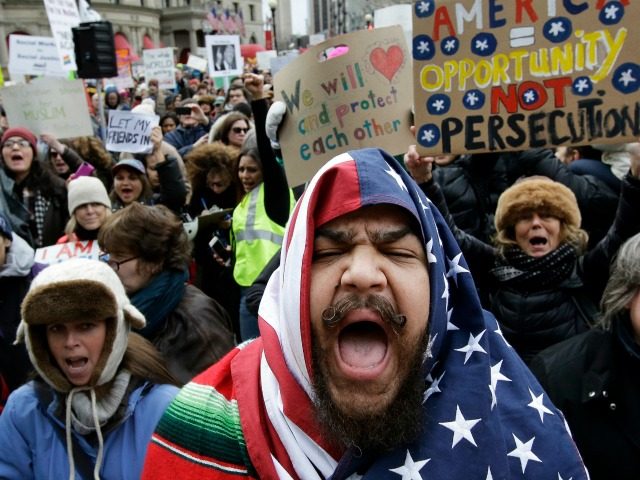Four months into FY 2018, refugee admissions into the United States have plunged to 6,708, the lowest level this far into a fiscal year in 15 years.
In the immediate aftermath of the September 11, 2001 attacks on the World Trade Center and the Pentagon, refugee admissions plunged to 2,840 during the first four months of FY 2002 (October 1, 2001 to January 31, 2002), and 5,340 the first four months of FY 2003 (October 1, 2002 to January 31, 2003) during the administration of George W. Bush.
The following year, refugee admissions during the first four months of FY 2004 (October 1, 2003 to January 1, 2004) jumped to 11,032, and remained at these much higher levels until now.
Overall, refugee admissions for FY 2002 were 27,110. They increased slightly to 28,881 in FY 2003, then jumped up to 52,818 in FY 2004, peaking at 84,995 in FY 2016, the last full year of the Obama administration.
On an annualized basis, if the level of refugee admissions for the remaining eight months of FY 2018 continue at the same rate as has been maintained for the first four months, total refugee admissions for FY 2018 will be less than 21,000, the lowest level since well before the September 11, 2001 attacks.
The 6,708 refugees admitted into the United States for the first four months of FY 2018 represents a 79 percent decline from the 32,448 admitted during the same four month period of FY 2017, all but ten days of which took place during the Obama administration.
Refugee advocates and the non-profit voluntary agencies (VOLAGs) that have collectively been paid more than $1 billion annually by the federal government for decades to resettle refugees were hopeful that a slight monthly increase in refugee admissions that had occurred from October to December might continue into January, but they were sorely disappointed.
A total of 1,248 refugees were admitted in October, 1,858 in November, and 2,217 in December.
But refugee admissions for January 2018 dropped to 1,368.
Christian refugees as a percentage of all refugees admitted were higher in January 2018 than in the first quarter of FY 2018, and Muslims were slightly lower.
“Refugee admissions to the United States in the first quarter of FY 2018 under the Trump administration fell 79 percent to 5,323, compared to 25,671 in the first quarter of FY 2017 during the last three full months of the Obama administration,” Breitbart News reported:
The faith background of refugees admitted to the United States during the first quarter of FY 2018, which began October 1, 2017 and ended on December 31, 2017, differed dramatically from that of refugees admitted during the same period one year earlier, from October 1, 2016 to December 31, 2016.
Only 13 percent of refugees admitted during the first quarter of FY 2018, or 715 out of 5,323, were Muslim, while 60 percent, or 3,210 out of 5,323, were Christian, according to the State Department’s interactive website.
In contrast, 46 percent of refugees admitted during the first quarter of FY 2017, or 11,851 out of 25,671, were Muslim, while 44 percent, or 11,377 out of 25,671, were Christian.
In January 2018, 69 percent of all refugees admitted, or 963 out of 1,385, were Christian, and 12 percent of all refugees admitted, or 166 out of 1,385, were Muslim.
The country of origin for arriving refugees in January 2018 differed somewhat when compared to the first three months, the first quarter, of the fiscal year.
As Breitbart News reported last month, “The top five countries of origin for refugees admitted during the first quarter of FY 2018 were: Bhutan (1,535), Democratic Republic of Congo (1,154), Burma (655), Ukraine (487), Eritrea (428).”
The top five countries of origin from refugees admitted in January 2018 were the Ukraine (292), the Democratic Republic of Congo (268), Bhutan (251), Burma (138), and Eritrea (111).
On January 29, the Trump administration lifted the ban on refugees from 11 “high risk” countries, but also announced that “additional security measures will be put in place for certain claimants.”
The new measures, to be implemented by the Department of Homeland Security, as Breitbart News reported, include:
- Additional screening for certain nationals of high-risk countries.
- Administering the USRAP in a more risk-based manner when considering the overall refugee admissions ceiling, regional allocations, and the groups of applicants considered for resettlement.
- A periodic review and update of the refugee high-risk country list and selection criteria.
“The changes came after a 90-day review of refugee admissions from Egypt, Iran, Iraq, Libya, Mali, North Korea, Somalia, South Sudan, Sudan, Syria and Yemen by the State Department, Department of Homeland Security and intelligence agencies,” Reuters reported.
Time magazine, however, reported that “The administration won’t publicly confirm the 11 countries. But officials say they intend to review the list and update it six months from now.”
It is unclear what impact the lifting of the restriction on admissions from these 11 “high risk” countries combined with the stricter security measure will have on the number of refugees admitted to the United States over the remaining eight months of FY 2018.

COMMENTS
Please let us know if you're having issues with commenting.